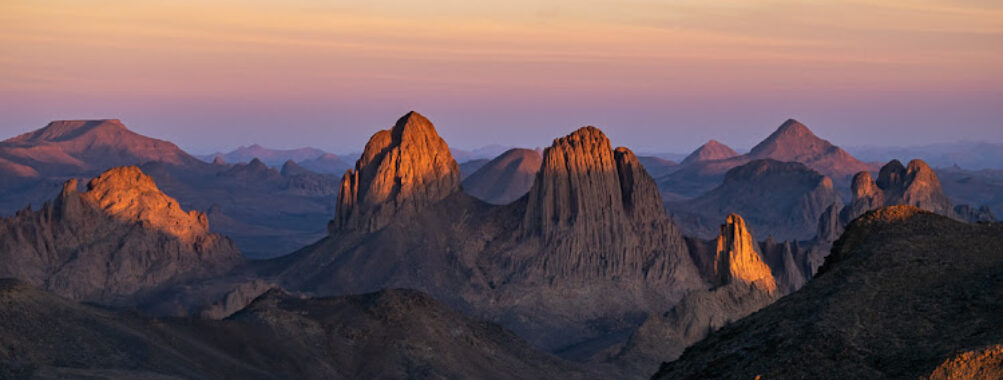
Ahaggar National Park
Table of Contents
Description
The Ahaggar National Park, also known as Hoggar, stands as one of Africa’s most spectacular natural wonders, spanning across the rugged Sahara Desert in southern Algeria. Let me tell ya, this place absolutely blew my mind when I first visited – it’s like walking on Mars, but with a whole lot more character! The park encompasses a massive expanse of dramatic volcanic peaks, wind-carved rock formations, and prehistoric rock art that’ll make your jaw drop.
What really sets Ahaggar apart is its otherworldly landscape of black basalt mountains rising dramatically from the orange-hued desert floor. The Atakor volcanic field dominates the region, with Mount Tahat proudly reaching up to 9,573 feet (2,918 meters), making it Algeria’s highest peak. And trust me, the view from up there is worth every step of the climb!
Key Features
• Ancient rock art galleries dating back thousands of years, showcasing the region’s rich cultural heritage
• The iconic Assekrem Hermitage, where Father Charles de Foucauld once lived, offering sunrise views that’ll literally take your breath away
• Distinctive geological formations including the “rock forest” of Tassili n’Ajjer
• Indigenous Tuareg communities maintaining their traditional nomadic lifestyle
• Rare desert wildlife including Saharan cheetahs, gazelles, and desert foxes
• Prehistoric archaeological sites featuring tools and artifacts from ancient civilizations
• Natural hot springs scattered throughout the park
• Unique desert vegetation adapted to extreme conditions
• Dark sky viewing opportunities that’ll make amateur astronomers weep with joy
• Traditional Tuareg markets where you can purchase authentic handicrafts
Best Time to Visit
Look, I learned this the hard way – timing is everything when visiting Ahaggar. The sweet spot is between October and March, when temperatures are actually bearable and you won’t feel like you’re melting into the desert sand. During these months, daytime temps hover around 68-77°F (20-25°C), perfect for hiking and exploring.
Summer months (June to September) are brutal, with temperatures soaring above 104°F (40°C). Trust me, you don’t wanna be scrambling up volcanic rocks in that heat! December and January can get surprisingly chilly at night, sometimes dropping below freezing, so pack accordingly if you’re planning a winter visit.
How to Get There
Getting to Ahaggar isn’t exactly a walk in the park, but that’s part of what makes it special. The main gateway is through the city of Tamanrasset, which you can reach via flights from Algiers. From there, you’ll need to arrange transportation into the park itself.
I gotta be honest – you’re gonna want to book through a licensed tour operator. They’ll handle all the necessary permits and provide 4×4 vehicles equipped for desert travel. Plus, their knowledge of the terrain is literally lifesaving in this environment. If you’re feeling adventurous, some operators offer camel treks, which is hands-down the most authentic way to experience the Sahara.
Tips for Visiting
After spending time here, I’ve picked up some essential wisdom that’ll make your visit way smoother. First off, you absolutely must bring more water than you think you’ll need – the desert air is sneaky dry and will dehydrate you faster than you’d expect.
Pack lightweight, loose-fitting clothes in natural fabrics, and don’t forget a good hat and sunscreen. The sun here means business! A reliable camera with extra batteries is essential – the lighting here is photographer’s dream, especially during golden hour.
Y’know what most people don’t realize? The temperature swing between day and night is huge. Pack warm layers for evenings, even in warmer months. And speaking of preparations, bring cash – there aren’t exactly ATMs scattered around the desert!
Always respect local customs and ask permission before photographing Tuareg people or their settlements. These folks are incredibly hospitable, but they value their privacy. Oh, and try to learn a few basic Arabic or Tamahaq phrases – it goes a long way with the locals.
For the best experience, plan to spend at least 3-4 days exploring. There’s just too much to see in a quick visit, and rushing through this landscape would be a real shame. And here’s a pro tip: bring some small gifts for your guides and the local communities – tea and coffee are always appreciated!
Remember, this isn’t your typical national park experience – it’s an adventure that requires proper planning and respect for both the environment and local culture. But boy, is it worth it! The memories you’ll make here will stick with you forever, just like that persistent sand in your shoes!
Location
Places to Stay Near Ahaggar National Park
Find and Book a Tour
Explore More Travel Guides
No reviews found! Be the first to review!